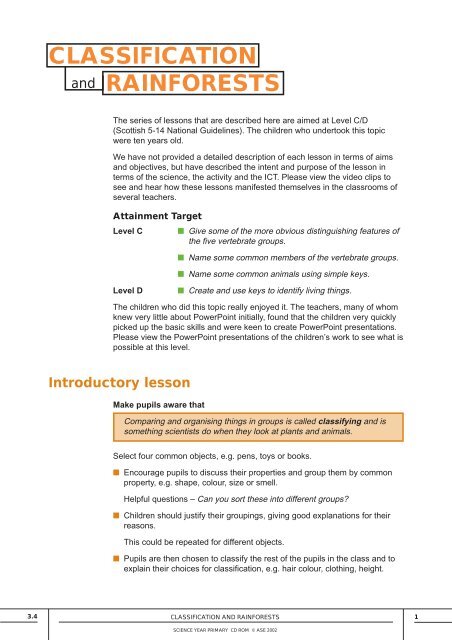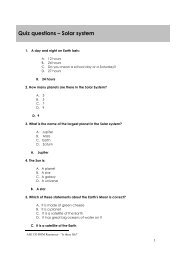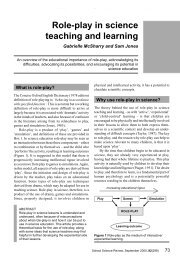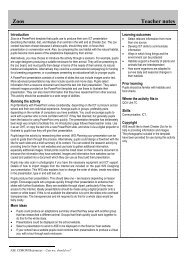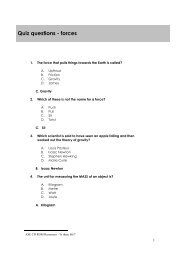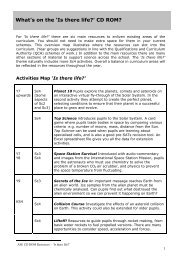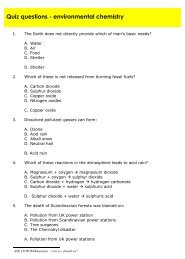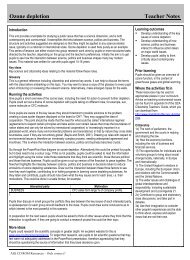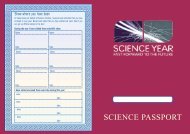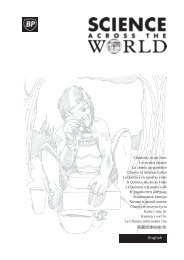Teachers - ASE Science Year CD Roms Online
Teachers - ASE Science Year CD Roms Online
Teachers - ASE Science Year CD Roms Online
You also want an ePaper? Increase the reach of your titles
YUMPU automatically turns print PDFs into web optimized ePapers that Google loves.
TEACHERS NOTES<br />
CLASSIFICATION<br />
and RAINFORESTS<br />
The series of lessons that are described here are aimed at Level C/D<br />
(Scottish 5-14 National Guidelines). The children who undertook this topic<br />
were ten years old.<br />
We have not provided a detailed description of each lesson in terms of aims<br />
and objectives, but have described the intent and purpose of the lesson in<br />
terms of the science, the activity and the ICT. Please view the video clips to<br />
see and hear how these lessons manifested themselves in the classrooms of<br />
several teachers.<br />
Attainment Target<br />
Level C<br />
■ Give some of the more obvious distinguishing features of<br />
the five vertebrate groups.<br />
■ Name some common members of the vertebrate groups.<br />
■ Name some common animals using simple keys.<br />
Level D<br />
■ Create and use keys to identify living things.<br />
The children who did this topic really enjoyed it. The teachers, many of whom<br />
knew very little about PowerPoint initially, found that the children very quickly<br />
picked up the basic skills and were keen to create PowerPoint presentations.<br />
Please view the PowerPoint presentations of the children’s work to see what is<br />
possible at this level.<br />
Introductory lesson<br />
Make pupils aware that<br />
Comparing and organising things in groups is called classifying and is<br />
something scientists do when they look at plants and animals.<br />
Select four common objects, e.g. pens, toys or books.<br />
■ Encourage pupils to discuss their properties and group them by common<br />
property, e.g. shape, colour, size or smell.<br />
Helpful questions – Can you sort these into different groups?<br />
■ Children should justify their groupings, giving good explanations for their<br />
reasons.<br />
This could be repeated for different objects.<br />
■ Pupils are then chosen to classify the rest of the pupils in the class and to<br />
explain their choices for classification, e.g. hair colour, clothing, height.<br />
3.4 CLASSIFICATION AND RAINFORESTS<br />
1<br />
SCIENCE YEAR PRIMARY <strong>CD</strong> ROM © <strong>ASE</strong> 2002
TEACHERS NOTES<br />
Lesson 2<br />
Make pupils aware that<br />
Scientists identify and classify animals by looking for distinguishing<br />
features.<br />
You could start by asking the children to group a range of toys. What do they<br />
use to help them group these toys?<br />
■ Ask the pupils to identify common animals or pets and then draw/paint<br />
these.<br />
■ The children can work in groups to classify these. Ask them to justify their<br />
classifications.<br />
■ Accept any justifications at this point.<br />
■ The groups then share their views. Accept any answers at this point,<br />
e.g. we can eat them, farm animals etc.<br />
Lesson 3<br />
Make pupils aware that animals can be divided into two sub groups:<br />
■ vertebrates – those with a backbone<br />
■ invertebrates – those with no backbone.<br />
Make pupils aware that scientists use<br />
Five common vertebrate groups:<br />
birds, reptiles, amphibians, fish and mammals.<br />
Explain that just as they have classified things in different ways, scientists<br />
have classified things. The classifications that scientists have used for animals<br />
and plants are now used by all scientists to try to avoid confusion between<br />
different people using different classifications.<br />
Explain what the five vertebrate groups are.<br />
■ Ask the children to work in groups to research the five classification<br />
categories and their features. They could use the Internet, <strong>CD</strong>-ROMs,<br />
books, etc.<br />
■ Each of the groups should look at one of the classification categories in<br />
more detail and define the characteristics relating to one particular<br />
category.<br />
3.4 CLASSIFICATION AND RAINFORESTS<br />
2<br />
SCIENCE YEAR PRIMARY <strong>CD</strong> ROM © <strong>ASE</strong> 2002
THE FIVE TEACHERS VERTEBRATE NOTES GROUPS<br />
Birds<br />
e.g. Common crow, penguins<br />
have feathers covering their body<br />
have wings<br />
lay eggs with hard shells<br />
have two legs.<br />
Reptiles<br />
e.g. Lizards, snakes, crocodiles<br />
have skin covered in scales<br />
lay eggs (which are soft shelled) on land.<br />
Amphibians<br />
e.g. Toads, frogs, salamanders, newts<br />
have a body that is covered in soft skin – no scales<br />
are able to live in water and on land<br />
lay eggs in water.<br />
Fish<br />
e.g. Salmon, trout, goldfish<br />
live in water<br />
scales covering their body<br />
have fins<br />
breathe using gills.<br />
Mammals<br />
e.g. Human beings, dolphins, dogs, monkeys<br />
give birth to live young<br />
feed their young milk<br />
have fur or hair covering their body<br />
www.homepages.which.net/~matthew.shanks/index.html<br />
Classification – by Anita Ganeri, Heinemann Library<br />
3.4 CLASSIFICATION AND RAINFORESTS<br />
3<br />
SCIENCE YEAR PRIMARY <strong>CD</strong> ROM © <strong>ASE</strong> 2002
TEACHERS NOTES<br />
Lesson 4<br />
Make pupils aware that<br />
Scientists identify and classify animals by looking for distinguishing<br />
features.<br />
They can use common keys to classify and identify animals.<br />
Give children some playdough, plasticine or clay.<br />
■ Ask them to design an animal that could live in a particular habitat, such as<br />
a forest, or a patch of grass near a road, or a field.<br />
■ Ask them to describe their animal and explain why their animal is best<br />
suited to where they live. What do they eat? How do they survive? Who are<br />
the predators?<br />
■ Then ask the children to use a classification key to group their animals.<br />
What sorts of criteria do they use?<br />
This also provides a tenuous but useful link to the topic of rainforests. Would<br />
their animal survive in a rainforest? What sorts of animals live in a rainforest?<br />
Lessons 5 and 6<br />
Make pupils aware that<br />
They can use common keys to sort animals.<br />
They can use PowerPoint to share information with others<br />
PowerPoint is a dynamic slide-show presentation which will allow you to<br />
include text, images, sound, graphics, and video. The following sites have<br />
information to help teachers create PowerPoint presentations.<br />
Key resources<br />
http://www.knc.lib.umich.edu/guides/<br />
An American site which includes help guides for PowerPoint – you will need<br />
Adobe Acrobat to read the pdf files for PowerPoint instructions.<br />
http://www.oucs.ox.ac.uk/ltg/reports/ppt.shtml<br />
This site, from Oxford University Computing services, has brief instructions.<br />
Do a ‘Blue Peter’ and show the children one you made earlier, or show them a<br />
PowerPoint presentation made by other children. Explain that they are going<br />
to collect information about particular animals that live in the rainforest and<br />
that they are going to create their own PowerPoint presentations for a certain<br />
audience. The audience may be their parents or carers at an open evening, or<br />
children in another class.<br />
3.4 CLASSIFICATION AND RAINFORESTS<br />
4<br />
SCIENCE YEAR PRIMARY <strong>CD</strong> ROM © <strong>ASE</strong> 2002
TEACHERS NOTES<br />
■ If the children are using PowerPoint to create their presentations, storage<br />
can become an issue if they include several graphics, animations or video<br />
clips, so you need to set limits.<br />
■ Encourage the children not to include too many multimedia components if<br />
you want the presentation to be portable. Sound and video clips require a<br />
lot of disk space.<br />
■ You can build in differentiation because you can either ask the children to<br />
use the templates available on the PowerPoint package or they can create<br />
their own presentation starting from basics.<br />
Group working Organise the children to work in groups. Each member has<br />
to collect information about a different animal that lives in the rainforest.<br />
Each member of the group can create one slide for the slide presentation.<br />
They will have to collate their information, analyse it and determine which<br />
bits they want to include.<br />
Saving work Once they have collected their information they can begin to<br />
investigate fonts and slide transitions. Ask the children to create and save their<br />
presentations in their own folders. Remind them to save their work frequently.<br />
Printing A hard copy of their presentation is useful when working off-machine.<br />
However, they should be encouraged to print only the sections to which they<br />
have made changes.<br />
Time management Give the children a set period of time to research, collect,<br />
prepare and present their information. You will notice that they want to spend<br />
all their time PowerPointing!<br />
Extension exercises<br />
The following are just brief suggestions for extension exercises.<br />
1 Once the children have designed their animals for a rainforest or a<br />
particular habitat, ask them to explain how the animal would survive if a<br />
forest fire swept through, or another natural disaster happened?<br />
What characteristics would enable their animal to survive?<br />
2 Once they have managed to create a simple PowerPoint presentation,<br />
using clip art of inserted pictures, teach them how to scan and import the<br />
images they have drawn.<br />
Teach them how to use action buttons to link to various screens.<br />
3.4 CLASSIFICATION AND RAINFORESTS<br />
5<br />
SCIENCE YEAR PRIMARY <strong>CD</strong> ROM © <strong>ASE</strong> 2002


